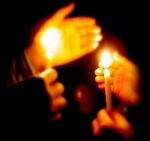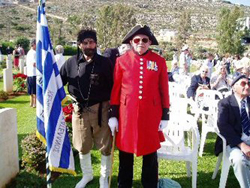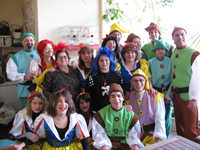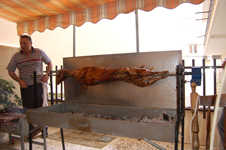Where to go on Crete
Obviously visiting the White Lady is an important reason for coming to Crete. You will also, of course, want to laze around the pool or chill out on the beach and there is nothing wrong with that. Crete, however, has a lot more to offer. This is not intended to be a guidebook to Crete, there are plenty of those on the market already and numerous websites extolling the virtues of the island. Really all I can hope to do here is to whet your appetites for Crete and encourage you to get a good guidebook (see below) before you arrive. Many of you return year after year to Crete. What is it that draws you back each time? For me, seeing the sights became unimportant; I came to meet the people of Crete, particularly my "family" at the White Lady (which is why I am now living here). Having said that, I do get around from time to time to see other places on the island.
I have divided this guide into three sections, Festivals & National Holidays, Places and Useful references.
Festivals & National Holidays
Most of the festivals and holidays are religious and based on the Orthodox calendar, which is why Greek Easter rarely falls on the same day as the western Easter. In addition there are many local festivals, called paniyiria which celebrate the patron saint of the village church. Even the non-religious would find it difficult not to be moved by some of the Easter activities, and there is always the eating and drinking that accompany many festivals to guarantee your participation.
Carnival (Apokries) and Clean Monday (Kathera Dheftera) ‡
Carnivals occur all over Greece during the three weeks prior to Clean Monday. The word carnival is from two Latin words meaning "Goodbye Meat". On the Thursday of the second of the three weeks is Tsiknopempti (literally smoky Thursday, the smoke coming from the barbecue). This is normally the first day that people dress up in costume. The carnival at Rethymno is one of the most famous of the Greek carnivals and is huge fun as you may have seen from the Carnival Website. Unfortunately it is well out of the normal holiday season, but if you are lucky enough to be on Crete then come prepared for a lot of serious fun. The main carnival parade in Rethymno takes place on the Sunday before Clean Monday. Clean Monday is the first day of the Lenten fast, so food like octopus, squid and shrimps is consumed (as usual in great quantities). Kite flying is traditional on the day. Details for the Carnival programme may be found on the Carnival Website but please note that you may need to wait a bit before you see the current year's pages. If you are trying to plan a break to fit in with the carnival you need to know when Clean Monday is; just do a search (in your favourite search engine) for "Clean Monday" followed by the year you are looking for.
Independence Day (March 25th)
Parades are held all over Greece celebrating the beginning of the revolt against Turkish rule in 1821 and the start of the modern Greek state. Crete finally became part of Greece in 1913.
Easter ‡

Easter in the Greek Orthodox calendar is the most important religious festival of the year. On Holy Thursday (Megali Pempti) the red eggs are prepared. The first big ceremony takes place on Good Friday (Megali Paraskevi) when Christ's funeral bier, the epitafios, is paraded through the streets of the parish to the accompaniment of (for me) one of the most moving of Byzantine hymns. On the morning of Good Friday the bier is decorated with flowers by the ladies of the parish. Late on Holy Saturday is a mass to celebrate the return of Christ from the dead, and at midnight all the lights in the church are extinguished. From behind the alter screen the priest brings a lighted taper, the Light of the World. Gradually, from this flame all the candles that the congregation have brought with them are lit. As one person passes the light to another he or she will say "Christos Anesti" (Christ is risen) to which the reply is "Alithos Anesti" (Truly He is risen) or "Alithos o Kyrios" (Truly He is the Lord). Before you know it the church is completely lit by candlelight. At the same time, church bells ring out, firecrackers are lit and efigees of Judas Iscariot are burned. The Lenten fast is now broken and so on Easter Day (To Pascha) most families roast a lamb and eat and drink a lot. You might not want to eat meat for a week or so afterwards.
For some reason package tour companies rarely have deals that start early enough for Greek Easter despite the fact that it is normally later than the western Easter.
In the area of the White Lady there are two chuches, Ayia Triadha (just after Platanes) and Ayios Nektarios (in Tsesmes). One of them does the Good Friday rites and the other the Holy Saturday rites. Antonia's mother Kiki will always know which is which.
‡ As Easter is a moveable feast, all dates based on Easter are moveable. If you want to know when Greek (Eastern) or Western Easter is for any year, I suggest you use your favourite search engine to look for "Easter Dates". Wikipedia have a good page showing Easter dates for the current year, 20 years in the past and 20 years in the future.

Battle of Crete (Around May 20th)
The anniversary is celebrated around Crete, but particularly at the official cemeteries. The main Allied ceremony is in Chania (Soudha) every year and also at the White Lady. The site in Soudha is lovingly looked after by the Commonwealth War Graves Commission. For the dates of any year's ceremonies send us a message in early May.
Summer Festivals in Rethymno
- Cretan Diet Festival (July)
- Rethymno Renaissance Festival (August)
NOTE: We are not resposible for any of the information published on external websites, nor for when they update them for the current year.
Ochi (No) Day (October 28th)
This is a national holiday in Greece and a parade is held in Rethymno. It commemorates the Greek Prime Minister Metaxas saying "Up yours" when asked in 1940 by the Italian ambassador if he would mind very much if the Italians invaded Greece. OK, he didn't say "Up yours", but then neither did he say "Ochi". He is reputed to have said "Alors, c'est la guerre" since the Italian Ambassador did ot speak Greek and Metaxas did not speak Italian.
Places
Around Crete
- Chania - the old town is beatiful, the Venetian harbour is very picturesque. A great place for leather bargains.
- Archeological Museum of Iraklio - here you can see the world's finest collection of Minoan treasures.
- Spinalonga - the last leper colony in Europe and the setting of Victoria Hislop's "The Island", once an impregnable Venetian fortress. Combine it with a vist to Elounda scene of "Who Pays the Ferryman" (now available on DVD from ebay or Amazon. It is now available (somewhat expensively) entirely in English. I have the version in the the Dutch packaging (the audio is in English and you can turn off the subtitles). It is worth watching, if only for Jack Hedley's very 70s clothing. The book is better and also available from ebay and Amazon (even a Kindle version).)
- Knosos - a 3500-year-old Minoan palace discovered and lovingly (mistakenly?) restored by the British archeologist Sir Arthur Evans. Combine it with a vist to the Archelogical Museum of Iraklio. Personally, I prefer the palace of Phaestos (on the road to Matala - the "Hippy" caves - and about 4km from Timbaki). Phaestos has been excavated but not restored so if you have an imagination you are free to "construct" your own palace. Also, it is rarely crowded with tourists.
- Vai beach - see the tropical date-palms fringing the beach, the largest palm beach in Europe and the scene for the "Bounty" adverts in the 60s.
- Samaria Gorge - Europe's longest (18km) gorge, and not a trip I would recommend for July and August as it will be heaving with tourists. Your tour representatives will tell you to take stout walking boots, lots of water and to wear a hat. Well, I have done it twice, and a decent pair of trainers is as much as you need. Water is readily obtainable from springs along the way to replenish your water bottle. As for a hat, well, there are some exposed parts of the gorge, but also lots of shade. Well worth doing if only for the beer you will want in Ayia Roumeli. Beer never tasted so good. You do need to be reasonably fit. If you have to give up part way through they have to take you out on a donkey.
- Elafonisi - An exotic coral reef lagoon with rose-tinted sand and turquoise seas. Unfortunately rapidly becoming a popular tourist spot, so it may be crowded on the day that you go.
Thanks to Heather Perry for the photographs of Elafonisi.
- Zoniana - High up in the Psiloritis range, just before the town of Anoyia is the small village of Zoniana. Here you can find some spectacular caves and a small waxworks museum depicting heroes of the revolution. Eleftherios Venizelos is also featured as he was from Chania and the first Prime Minister of Greece.
In and around Rethymno
- Forteza - the old Venetian fortress designed by Sforza Pallavicini, it took ten years to build. It was built in response to raids on Rethymno by the pirates Barbarossa and Uluch Ali. The view of the town from the walls is spectacular
- Archeological Museum - opposite the entrance to the Forteza, it has a good collection of Minoan pottery and sarcophagi, as well as many Roman artefacts
- The Old Town - see the Rimondi fountain and the Nerandzes Mosque. A good area to find a café and watch the world go by whilst playing with your komboloi or writing postcards
- Margarites - famous as the potters village. Just about every street has a potters workshop and shop where you can find some great souvenirs. If you have room in your luggage you could even take home one of the giant pithoi that you will see in Knosos. Combine it with a trip to the Arkadhi Monastery and/or the Melidhoni Cave(see below)
Argiroupolis
A little way towards Chania on the Old Road is the village of Argiroupolis. Cretan village life continues much the same as it has always done. The village, as you can see from the photographs, has some very beautiful waterfalls.
Melidhoni Cave
The cave is one of the most impressive on Crete and signs of inhabitation have been discovered dating back to the Neolithic period. In mythology, it was the home of Talos, who protected the coasts of Crete by hurling rocks at unfriendly ships. The cave was also an important Minoan shrine. In 1824 370 civilians and 30 solidiers died as martyrs. They had taken refuge in the cave during the struggle for Cretan independance. The Turkish army blocked the entrance to the cave, lit a fire and chanelled the smoke into the cave and over a period of a few days choked to death the Cretans hiding within. A shrine near the entrance to the cave commemorates the dead.
There is a small café next to the ticket office where you can sit and enjoy the views over the surrounding countryside. The proprietors of the café and the ticket office speak excellent English.
Arkadhi Monastery
The date of the foundation of the Monastery is not known. The earliest written inscription dating from the 14th century verifies that the original church, dedicated to Saints Constantine and Helen (Άγιοι Κωνσταντίνος και Ελένη - Ayii Konstantinos ke Eleni), was built during the same period. Towards the end of the 16th century (1587) the monastery underwent restoration and the church that you see today dates from that time. The new church was dedicated to the Metamorphosis of Christ (Μεταμόρφωση του Χριστού - Metamorfosi tou Christou). To day the northern aisle (left as you look towards the iconostasis) is dedicated to the latter, and the southern aisle to the former. Before the event that made it famous (see below), the monastery was one of the richest in Crete and a well known stop-over for travellers.
The Monastery acquired glory and fame on an international scale during the Cretan Revolution of 1866-1869. Mustapha Pasha had attacked the rebellious inhabitans of Réthimno and some 700 women and children from nearby villages sought refuge in the monastery. In charge of the garrison at Arkadhi was Colonel Koroneos who, realising that the monastery could not provide sufficient defence, left with some of his men to distract the Ottomans away from the region. This left 287 armed men in the garrison of whom 45 were monks and 20 volunteers under the command of Lieutenant Dhimakopoulos. There were also 12 of the 16 members of the Central Revolutionary Committee, including its chairman, the Abbot Gavriïl (Gabriel).
Following a three-day battle, the Ottoman artillery eventually broke down the monastery gates and on entering slaughtered everyone in its path. The Abbot gathered all those remaining alive in the monastery's gunpowder store and, together with another hero, Konstantinos Yiamboudhakis he blew up the gunpowder, martyring all those inside, but also taking hundreds of Ottoman soldiers with them.
This heroic resistance shocked not only Greeks, but also Europe's politicians and intellectuals and the press in Europe and the United States wrote articles in favour of liberty for the Cretans. Celebrations of the anniversary of the blast are held each year on November 7th to 9th. Crete finally gained independence in 1898 and joined Greece officially in 1913. †
† Based on "The Monastery of Arkadi", Provotakis T M, Page 14 (available from the monastery museum shop).
References
If you are looking for a guide book on Crete then look no further than "The Rough Guide To Crete" To quote my favourite travel author, Bill Bryson, "Rough Guides are consistently readable, informed and, most crucially, reliable". They also publish a good map of Crete on waterproof, rip-proof paper. The only other decent map I have seen is published by Road Editions (Ilía Iliou 41, 117 43 Athina, Tel: + 30 210 929 6541) and is available in all good bookshops in Greece (also available in German and Italian). Do remember that all guide books can become out of date very quickly.
The Rough Guide to Crete is now available as an e-book in ePub, azw, mobi and pdf formats. Don't forget, Kindle users, you can also put mobi format books on your Kindle.






























